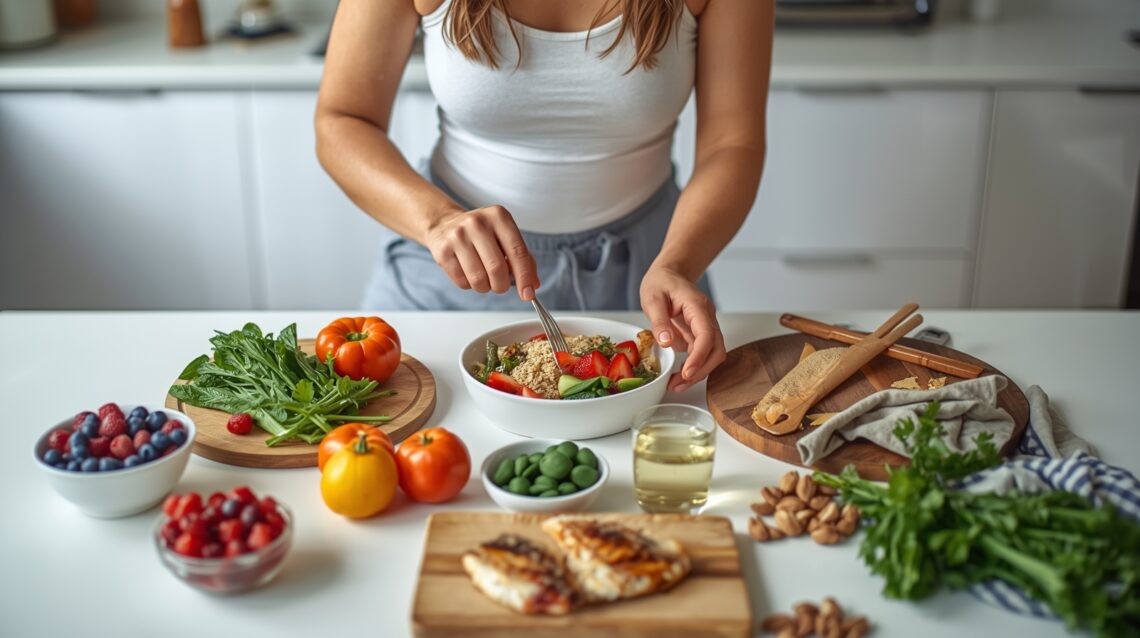Fat loss depends on creating a calorie deficit, supporting metabolism, and maintaining muscle mass. Nutrition plays a major role in this process. Certain foods can help increase calorie expenditure, stabilize blood sugar, and provide essential nutrients needed for metabolism.
This guide outlines ten foods that contribute to fat loss, explains how they support the body, and offers practical ways to include them in daily meals.
Section 1: Understanding Fat-Burning Foods
Fat-burning foods do not melt fat instantly. They support the body in:
Increasing thermogenesis (calories burned during digestion)
Supporting stable blood sugar levels
Reducing cravings
Preserving lean muscle mass
In combination with physical activity, adequate sleep, and hydration, these foods improve the efficiency of weight management.
Section 2: Lean Protein Sources
Protein supports muscle maintenance and requires more energy to digest than carbohydrates or fats.
Examples:
Chicken breast
Turkey
Lean cuts of beef
Fish such as salmon or cod
Plant-based options like lentils, beans, or tofu
Benefits for fat loss:
Increases calorie expenditure through digestion
Supports muscle repair
Improves satiety
Practical tip:
Include protein in every meal. For example, eggs or Greek yogurt for breakfast, a chicken salad for lunch, and fish with vegetables for dinner.
Section 3: Whole Grains
Whole grains digest slowly, stabilizing blood sugar and insulin levels.
Examples:
Oats
Quinoa
Brown rice
Barley
Whole wheat
Benefits for fat loss:
Provides energy for workouts
Reduces overeating
Supports digestive health
Practical tip:
Swap refined grains with whole grains. For instance, use quinoa in place of white rice or whole oats instead of sugary cereals.
Section 4: High-Fiber Vegetables
Vegetables provide fiber, micronutrients, and volume without excess calories.
Examples:
Broccoli
Spinach
Kale
Cauliflower
Bell peppers
Benefits for fat loss:
Increases fullness
Supports gut health
Reduces calorie density of meals
Practical tip:
Include vegetables in every meal. Add spinach to eggs, include a large salad with lunch, or steam broccoli as a side dish.
Section 5: Healthy Fats
Dietary fat supports hormone function and satiety. Including the right fats prevents overeating.
Examples:
Avocado
Olive oil
Nuts such as almonds or walnuts
Seeds such as chia or flax
Fatty fish like salmon
Benefits for fat loss:
Stabilizes blood sugar
Supports hormone production
Improves nutrient absorption
Practical tip:
Use olive oil in salads, add avocado to toast, or sprinkle seeds on yogurt.
Section 6: Berries
Berries are low in sugar, high in fiber, and rich in vitamins that support metabolism.
Examples:
Blueberries
Raspberries
Strawberries
Blackberries
Benefits for fat loss:
Reduces calorie density of meals
Stabilizes blood sugar
Provides antioxidants for overall health
Practical tip:
Add berries to oatmeal, smoothies, or as a snack with nuts.
Section 7: Green Tea
Green tea contains compounds that support metabolic activity and fat oxidation.
Benefits for fat loss:
Increases energy expenditure
Enhances fat oxidation during exercise
Supports hydration
Practical tip:
Drink 1–3 cups per day, preferably without sugar. Replace coffee with green tea during the afternoon to reduce caffeine dependency.
Section 8: Legumes
Legumes are rich in protein and fiber, which support satiety and blood sugar control.
Examples:
Lentils
Chickpeas
Black beans
Kidney beans
Benefits for fat loss:
Slows digestion
Prevents spikes in blood sugar
Supports muscle preservation
Practical tip:
Use lentils in soups or chickpeas in salads for a filling, nutrient-dense meal.
Section 9: Spices and Metabolism Boosters
Certain spices mildly increase thermogenesis and may support digestion.
Examples:
Cayenne pepper
Cinnamon
Turmeric
Ginger
Benefits for fat loss:
Supports calorie burn
Reduces inflammation
Enhances flavor without calories
Practical tip:
Add spices to meals and beverages. For instance, cinnamon in oatmeal, ginger in tea, or turmeric in roasted vegetables.
Section 10: Water-Rich Foods
Foods with high water content reduce overall calorie intake and improve hydration.
Examples:
Cucumbers
Watermelon
Zucchini
Lettuce
Benefits for fat loss:
Reduces hunger
Supports metabolic processes
Maintains energy levels
Practical tip:
Include water-rich foods as snacks or side dishes. Start meals with a salad to reduce total calorie intake.
Section 11: Meal Planning with Fat-Burning Foods
A balanced diet combines protein, fiber, healthy fats, and nutrient-dense foods.
Example Day:
Breakfast: Oatmeal with Greek yogurt and berries
Snack: Apple with almond butter
Lunch: Grilled chicken salad with olive oil dressing
Snack: Carrot sticks with hummus
Dinner: Baked salmon with quinoa and steamed broccoli
Meal preparation ensures these foods are readily available and reduces reliance on processed options.
Section 12: Combining Foods with Exercise
Fat-burning foods support activity. Proper nutrition before and after workouts optimizes results.
Pre-workout:
Banana with peanut butter
Oats with milk
Post-workout:
Protein smoothie with berries and spinach
Lean protein with whole grains
These combinations maintain energy, prevent muscle breakdown, and support recovery.
Section 13: Role of Sleep in Fat Loss
Sleep regulates appetite hormones and metabolism. Poor sleep increases hunger and reduces calorie expenditure.
Tip:
Maintain 7–8 hours of sleep.
Avoid late-night snacking.
Pair sleep with nutrient-rich foods for optimal results.
Section 14: Tracking Progress
Tracking food intake, body measurements, and energy levels improves adherence.
Tools:
Apps for logging meals
Weekly body measurements
Keeping a habit journal
Data helps identify patterns and ensures consistency.
Section 15: Avoiding Common Pitfalls
Relying solely on one “fat-burning” food.
Skipping meals and reducing energy.
Overconsumption of processed foods.
Ignoring hydration.
A combination of foods, activity, and rest is necessary for sustainable results.
Section 16: Supporting Hormonal Balance
Fat-burning foods contribute to hormone regulation. Protein, healthy fats, and complex carbs stabilize insulin and estrogen levels, reducing fat storage and cravings.
Tip:
Include balanced meals throughout the day.
Avoid excessive sugar and processed foods.
Section 17: Mental and Emotional Considerations
Weight loss requires consistency and patience. Tracking small successes builds motivation. Incorporating foods that support satiety reduces emotional eating.
Strategies:
Plan meals ahead.
Include favorite foods in moderation.
Use mindful eating techniques.
Section 18: Long-Term Maintenance
After reaching weight goals, these foods help maintain results.
Maintenance tips:
Continue to include lean protein, vegetables, and whole grains.
Adjust portion sizes based on activity levels.
Monitor energy and weight trends monthly.
Section 19: Integrating Variety
Variety prevents dietary fatigue and ensures nutrient balance. Rotate proteins, vegetables, grains, and fruits to cover all essential nutrients and maintain enjoyment.
Section 20: Summary of Top 10 Fat-Burning Foods
Lean protein (chicken, fish, tofu)
Whole grains (oats, quinoa, brown rice)
High-fiber vegetables (broccoli, spinach, kale)
Healthy fats (avocado, olive oil, nuts)
Berries (blueberries, raspberries, strawberries)
Green tea
Legumes (lentils, chickpeas, beans)
Spices (cinnamon, turmeric, ginger, cayenne)
Water-rich foods (cucumber, lettuce, zucchini)
Hydration (water and herbal teas)
These foods, combined with exercise, sleep, and stress management, support fat loss and overall health.





